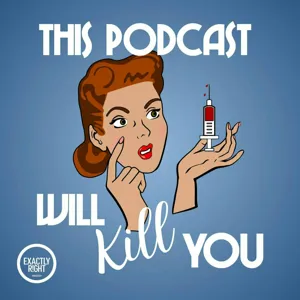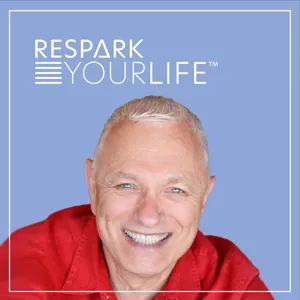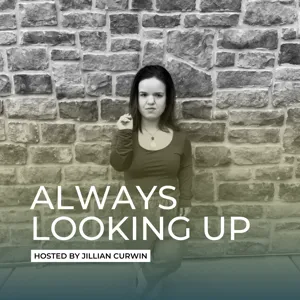Podcast Summary
Born with a rare bone disease, speaker faced numerous challenges: Despite a challenging childhood marked by frequent bone breaks and lack of resources, the speaker's love, support, and imagination helped her thrive
Despite an unconventional start to life, marked by the birth of Groundhog Day in an Appalachian winter, a broken collarbone, and later, a broken femur, the speaker's experiences shaped her into a resilient and imaginative individual. Born with a rare bone disease called osteogenesis imperfecta (OI), she faced numerous challenges, including frequent bone breaks and scoliosis. However, she emphasizes that her childhood was filled with love and support from her family, who helped her navigate the world with joy and independence. Her disability also fueled her passion for reading and writing, allowing her to explore limitless possibilities through her imagination. The lack of resources and information available to her parents at the time only strengthened their determination to help her thrive. Overall, the speaker's story underscores the importance of love, support, and imagination in overcoming adversity.
Using imagination to overcome challenges: Imagination can provide courage during tough times, and living with a disability can bring unique perspectives to storytelling.
Fiction and imagination have the power to help us overcome real-life challenges and instill courage within us. The speaker shares her personal experience of using her imagination of Aslan from "The Lion, the Witch, and the Wardrobe" to get through the painful process of having her leg set in the hospital. She also reflects on how her disability, Osteogenesis Imperfecta (OI), has impacted her life, from her childhood to her career as a children's novelist. She notes the challenges of advocating for her health when her disability is invisible and how it has affected her career unexpectedly. The speaker shares her recent experience of writing a novel, "Hummingbird," about a girl with OI, and how her own experiences helped her write an authentic story. Ultimately, she highlights the importance of embracing the complexities of living with a disability and finding the heart and magic in everyday life.
Everyone deserves to feel accepted and loved: Natalie Lloyd's message emphasizes the importance of acceptance and inclusion for all kids, regardless of their physical differences, and encourages them to believe in the magic and joy of their lives.
No matter what our bodies look like or how they function, we all deserve to feel accepted, loved, and have a sense of belonging. This was a powerful message shared by author Natalie Lloyd as she spoke about her experiences growing up with Osteogenesis Imperfecta (OI) and writing her book, "Hummingbird." She recalled feeling left out and self-conscious during her adolescence due to her condition, but was grateful for the love and support she received from her family and friends. Lloyd emphasized that a person's body is the least interesting thing about them, but also expressed her passion for writing books that promote acceptance and inclusion for all kids, regardless of their physical differences. She shared a particularly poignant scene from her book where her character, Olive, questions whether her body will hinder her from living a fulfilling life. Lloyd reassured kids that they get to have a big, amazing life in the body they're in and encouraged them to believe in the magic and joy that awaits them. Overall, Lloyd's story is a reminder that everyone deserves to feel seen and valued, regardless of their physical appearance or abilities.
Understanding the complexities of Osteogenesis Imperfecta: Osteogenesis Imperfecta is a disorder of collagen formation, characterized by bones that are prone to fracture, but it's much more complex than that. Dozens of potential mutations and a wide range of clinical phenotypes exist.
Osteogenesis imperfecta, or brittle bone disease, is a disorder of collagen formation. Collagen is a protein made up of specific amino acids, including glycine, proline, hydroxyproline, and hydroxylysine. It forms in a triple helix structure, and multiple of these helices come together to form larger collagen fibers and networks. Historically, osteogenesis imperfecta was classified into four types based on severity, but now we know that there are dozens of potential mutations involved and a wide range of clinical phenotypes. Osteogenesis imperfecta is characterized by bones that are prone to fracture, but it's much more complex than that. The discussion also touched upon a collagen fizz recipe and the wealth of resources available on the podcast's website, including transcripts, music, merchandise, and links to bookshop.org and Patreon.
The Importance of Collagen: A Complex Protein Family: Collagen, a family of five distinct proteins, is crucial for our bones, muscles, skin, and blood vessels. Disruptions in its production can lead to health issues.
Collagen, a family of proteins that makes up a significant portion of our body, is crucial for our health. Collagen is not just one type of protein, but a complex structure made up of five different types, each with distinct roles in our body. These proteins are responsible for various structures in our body, including our bones, muscles, skin, and blood vessels. Our bones, primarily composed of type 1 collagen, are just one example of its importance. The etymology of collagen, meaning "glue generating," is an accurate description, as it holds us together. However, due to its complexity, issues can arise in the production of collagen, leading to disorders like osteogenesis imperfecta. This condition, caused by mutations in genes encoding for type 1 collagen, affects the quantity or quality of this protein, resulting in various degrees of bone fragility. While the majority of cases are caused by autosomal dominant mutations in COL1A1 and COL1A2, there are many different specific mutations, making the condition complex and varied. Overall, collagen's significance in our bodies is vast, and any disruption in its production can lead to various health issues.
Understanding the Complexities of Osteogenesis Imperfecta: Osteogenesis imperfecta, or brittle bone disease, is a genetic condition causing variable symptoms due to collagen production or structure mutations. Researchers work to link genotypes to symptoms and develop targeted treatments.
Osteogenesis imperfecta (OI), also known as brittle bone disease, is a complex condition caused by various genetic mutations affecting the production or structure of type 1 collagen. The classification system for OI is still evolving, as researchers work to link known genotypes to individuals and develop targeted treatments. The mutations can lead to significant variation in symptoms, from mild to severe, making it essential to understand the underlying genetic causes. Common symptoms include easily fractured bones, short stature, bony deformities, blue sclera, and hearing loss. While some mutations result in reduced collagen production, others impact the collagen's structure and mechanical properties, leading to bones that are more fragile. Ongoing research aims to develop targeted therapies based on the specific genetic mutations, while recognizing that some treatments may be applicable to a broader range of cases.
Osteogenesis Imperfecta: Causes and Variability of Symptoms: Osteogenesis Imperfecta (OI) is a genetic condition caused by mutations in collagen genes, leading to weak bones and teeth. Symptoms range from mild to severe, with some forms affecting tooth development. Mutations impact collagen production or modifications. Most OI cases are inherited, with 85-90% caused by mutations in COL1A1 and COL1A2 genes.
Osteogenesis imperfecta (OI) is a group of disorders caused by mutations in the collagen genes, leading to weakened bones and teeth. The severity of symptoms varies widely, from mild impairments to severe physical disabilities or even death. Some forms of OI, such as dentinogenesis imperfecta, affect tooth development, causing small, discolored, and weak teeth. The degree of collagen impairment and the timing of the mutation determine the severity of the condition. For instance, null mutations impair collagen production, while mutations affecting collagen modifications lead to structurally unsound collagen. Most types of OI are autosomal dominant, but some are recessive. The proportion of inherited versus spontaneous cases is not clear, but approximately 85-90% of OI cases are caused by mutations in the COL1A1 and COL1A2 genes.
Ehlers-Danlos Syndrome: Causes, Symptoms, and Treatments: EDS is a group of disorders caused by collagen mutations, leading to joint hypermobility, skin fragility, and potential organ complications. Treatment includes physical therapy and medications, but effectiveness varies and new classifications may emerge.
Ehlers-Danlos Syndrome (EDS) is a group of disorders caused by mutations in collagen, a protein essential for healthy connective tissue. These mutations can result in various symptoms, including joint hypermobility, skin fragility, and organ complications. The severity and manifestations of EDS can greatly vary, with some forms leading to lethal or severe diseases due to impacts on bones, particularly in the torso, and the heart and lungs. Treatment primarily involves physical therapy to strengthen muscles and protect bones, along with medications like bisphosphonates that help with bone mineralization and decrease turnover. However, the effectiveness of these treatments is not definitively proven, and the vast array of possible mutations and resulting symptoms may eventually lead to different classifications of EDS as distinct diseases. Additionally, it's important to note that collagen supplements, such as powders, may not be effectively absorbed through the digestive system.
The history of osteogenesis imperfecta is complex and challenging to trace: Despite early records, understanding of osteogenesis imperfecta has evolved significantly over time, leading to improved care and treatments for those affected
The history of osteogenesis imperfecta, like the history of many diseases, is not always clear-cut. The first recorded evidence of the condition dates back to ancient Egypt around 1,000 BCE, but there are no known references to it in ancient texts. The legend of Ivar the Boneless, a Viking king believed to have had the condition, is an intriguing piece of folklore but lacks concrete historical evidence. The author of a 1980 paper on the history of osteogenesis imperfecta noted the challenges of accurately tracing the origins of medical conditions due to the potential for errors and biases in quoted sources. Instead of focusing on who first described the condition, it's more valuable to understand how our understanding of osteogenesis imperfecta has evolved over time and the impact that has had on those living with the disease. This divide between knowledge and application has shrunk significantly, but there is still much to learn and discover.
Early records of Osteogenesis Imperfecta: Historical accounts of Osteogenesis Imperfecta date back to the 17th century, but the cause of the condition remained uncertain until the late 19th century when it was identified as a genetic disorder.
The historical records of osteogenesis imperfecta (OI) are filled with conjecture and uncertainty. Ivar the Boneless, a legendary Viking leader, is often mentioned in connection with OI, but his existence and cause of his condition remain uncertain. The earliest possible reference to OI is from the 17th century by Nicolas de Malabranche, who attributed the condition to the mother's emotional distress caused by witnessing a public execution. However, this theory lacks scientific basis and is widely discredited. A more reliable account is from a medical report in 1690, describing a woman with symptoms consistent with OI, whose bones were fragile and easily broken. Despite these early records, the cause of OI remained a mystery until the late 19th century, when it was identified as a genetic condition. The historical records serve as a reminder of the challenges in accurately diagnosing and understanding rare conditions in the past.
Early Descriptions and Naming of Osteogenesis Imperfecta: Osteogenesis Imperfecta (OI) was first clearly described in the 19th century by Edmund Axman, who identified its four major characteristics. It was later named by Gerardus Vrolijk and the genetic cause discovered in the 20th century. Pain is a significant component due to fractures and healing process.
The earliest descriptions of Osteogenesis Imperfecta (OI) date back to the 17th and 18th centuries, with various researchers and physicians making observations and assumptions about the condition. However, it wasn't until the 19th century that the first clear and distinct description of OI's four major characteristics - bone fragility, joint hypermobility, blue sclera, and a frail body - was made by Edmund Axman. The condition was later named by Gerardus Vrolijk in the early 19th century, and it wasn't until the 20th century that the genetic cause of OI was discovered. Despite early misconceptions, pain is a significant component of OI due to the fractures and the way bones heal, leading to additional damage and potential pain down the line.
From observations to understanding Osteogenesis Imperfecta: Through decades of research, the cause of Osteogenesis Imperfecta was gradually uncovered, starting with observations of its association with blue sclera and hereditary nature, and eventually leading to an understanding of the role of collagen in the condition.
The history of understanding Osteogenesis Imperfecta (OI) involved decades of incremental progress and repetition, with numerous researchers adding pieces to the puzzle. In the late 1800s, several observations were made about the condition, including its association with blue sclera and hereditary nature. However, it wasn't until the 1900s that researchers began to recognize the involvement of various body systems beyond bones and eyes. By the first half of the 20th century, there was a general clinical description and diagnostic criteria for OI, but the underlying causes of the condition remained a mystery. It wasn't until the 1960s and 1970s, with advancements in research on collagen, that the physiological reasons for OI began to be understood. This history highlights how most scientific progress occurs through incremental steps, with many researchers building upon each other's work.
Decades-long journey to understand collagen and its role in Osteogenesis Imperfecta: Collagen identification led to treatments for OI, including bisphosphonates, and fostered community support, but gene therapy is a potential future breakthrough
The discovery and understanding of collagen, the most abundant protein in our bodies, took decades due to the lack of necessary technology and background knowledge. Once identified, researchers were able to make significant strides in understanding the genetic causes of osteogenesis imperfecta (OI), a disorder involving collagen. While there have been advancements in treating fractures through physiotherapy, rehabilitation, and orthopedic surgery, medications to address bone density loss and pain didn't emerge until the late 1980s. Bisphosphonates, a type of drug used for bone mass loss in other conditions, showed promise in increasing bone mass for people with OI. However, it's important to remember that these treatments not only have physical benefits but also significant emotional and social impacts, like reducing fear and anxiety, and fostering community through organizations and awareness campaigns. Despite these advancements, expensive and potentially game-changing treatments like gene therapy are on the horizon.
Osteogenesis Imperfecta: A Rare Genetic Disorder Affecting Bone Health: Current research focuses on a new drug inhibiting sclerostin to increase bone formation and decrease bone resorption, potentially benefiting most Osteogenesis Imperfecta cases, despite underestimated global prevalence and ongoing research in gene therapy.
Osteogenesis imperfecta (OI) is a rare genetic disorder, estimated to affect approximately 1 in 15,000 people worldwide and around 240 people in the US each year based on birth statistics. However, these numbers are likely underestimates as many cases go undiagnosed, particularly in less severe forms or later in life. Current research focuses on a new drug in clinical trials, which inhibits the protein sclerostin to increase bone formation and decrease bone resorption, potentially leading to stronger bones and fewer fractures. The treatment is not mutation-specific and has the potential to help most OI cases. While there is ongoing research, particularly in gene therapy, there is currently limited information available on the global prevalence and variability of OI in different countries. The process of bone remodeling, which involves the body resorbing and remodeling bone, is a complex process that is essential for bone health. Inhibiting bone remodeling could potentially have downsides, particularly for individuals with already fragile bones, but the potential benefits of increased bone formation and decreased bone resorption are promising.
Research on mental health and quality of life for Osteogenesis Imperfecta: The Osteogenesis Imperfecta Foundation is leading research to improve mental health and quality of life for those with the disorder. Studies are underway at Baylor College of Medicine. It's crucial to focus on these aspects as they are often overlooked in chronic disorders.
While there have been numerous treatments for the bone components of Osteogenesis Imperfecta (OI) throughout history, ongoing research is focusing on improving mental health and quality of life for those living with the disorder. The Osteogenesis Imperfecta Foundation is leading efforts in this area, with studies underway at Baylor College of Medicine. For a deeper understanding of OI, sources such as the 1980 Weil article "Osteogenesis Imperfecta: Historical Background" and the 2014 Silence and Lamond chapter "Evolution of the Present Understanding of the Clinical and Genetic Heterogeneity and molecular and biochemical basis of osteogenesis imperfecta" are recommended. Additionally, there are numerous papers on collagen, the current understanding of OI, and ongoing investigations into treatments available. It's important to note that mental health and quality of life are often overlooked aspects of chronic disorders, and ongoing research in these areas is crucial.




